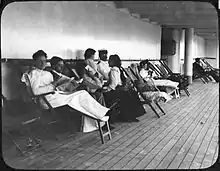SS Trent
SS Trent was a steamship built by Robert Napier and Sons of Govan in 1899 for the Royal Mail Steam Packet Company.
| History | |
|---|---|
| Name: | Trent |
| Owner: | Royal Mail Steam Packet Company |
| Builder: | Robert Napier and Sons |
| Yard number: | 467 |
| Launched: | 18 September 1899 |
| In service: | January 1900 |
| Out of service: | 1922 |
| Fate: | Scrapped at Rotterdam in February 1922 |
| General characteristics | |
| Tonnage: | |
| Length: | 410 ft (124.97 m) |
| Beam: | 50 ft (15.24 m) |
| Draught: | 23.3 ft (7.10 m) |
| Depth: | 32.3 ft (9.85 m) |
| Installed power: |
|
| Propulsion: | Single screw |
| Sail plan: | Two masts |
History
Trent was used as a mailship in the North Atlantic. On 6 June 1909 she ran aground on Semedine Bank, near Cartagena, Colombia. She remained aground until May.[1] On 18 October 1910 Trent rescued the crew of the airship America 410 mi (659.83 km) southeast of Sandy Hook after their failed first attempt to cross the Atlantic by air.[1][2]
On 6 March 1915 Trent was requisitioned as a depot ship by the Admiralty and assigned to support the river monitors HMS Humber, HMS Mersey and HMS Severn during the Gallipoli campaign. Trent was used to transport the monitors' crews to Malta, while the monitors themselves were towed there by tugs. Trent continued to be used in support of the monitors, accompanying Mersey and Severn to East Africa in July 1915, for their attack on the SMS Königsberg on the Rufiji River.[1] Trent later returned to British waters, on 1 October 1917 became the depot ship for HMS Icarus, the Royal Naval Air Service base at Houton Bay, Scapa Flow. Here she supported the Orkney Air Service's anti-submarine patrols until March 1918.[1] Trent was returned to the Royal Mail Steam Packet Company shortly after the end of the war, on 23 January 1919.[1] She was broken up at Rotterdam in February 1922.[1]

References
- "Screw Steamer Trent". clydeships.co.uk. Clyde-built Ship Database. Retrieved 8 November 2019.
- Unknown. "Thames Tugs". Thames Tugs. Retrieved 25 June 2015.
